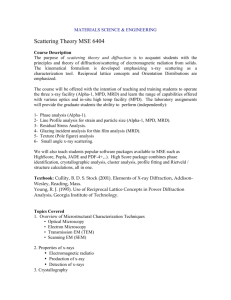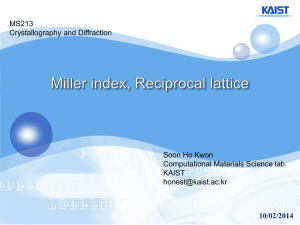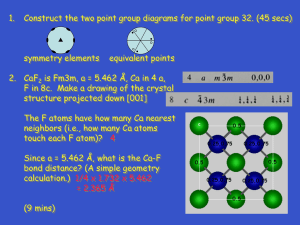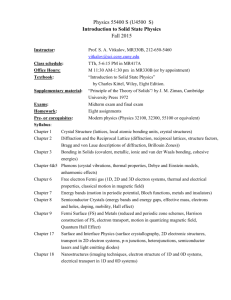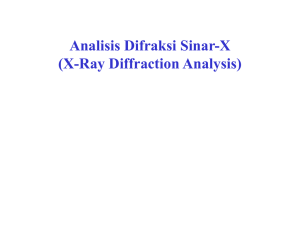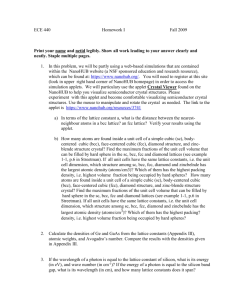Microsoft Word Format
advertisement
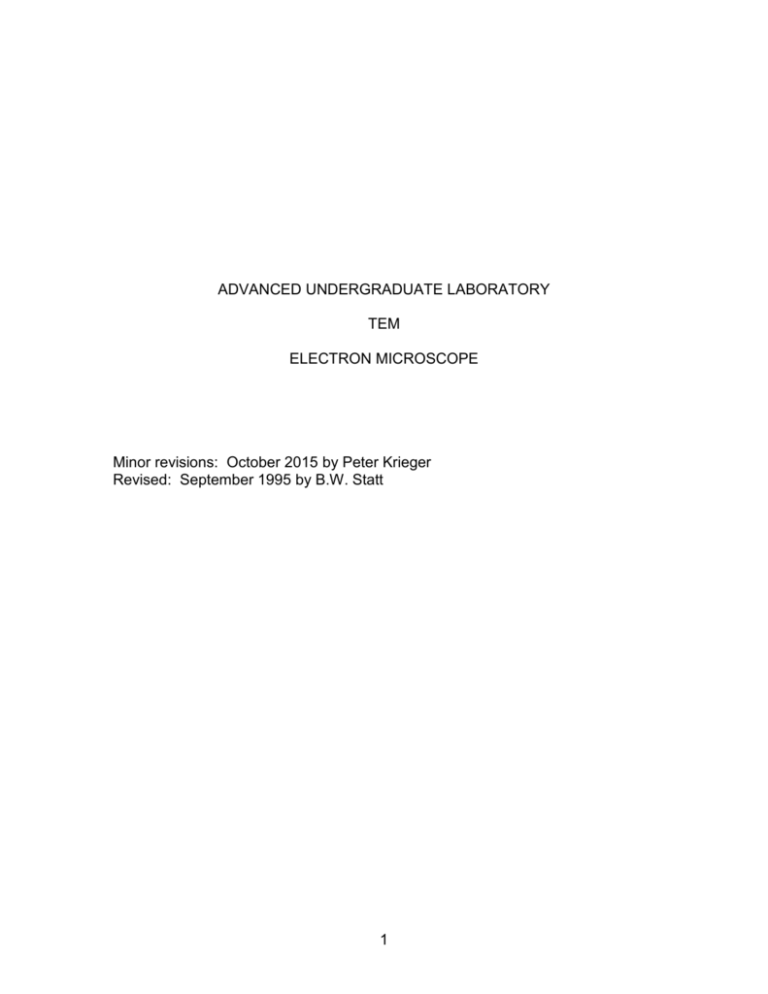
ADVANCED UNDERGRADUATE LABORATORY TEM ELECTRON MICROSCOPE Minor revisions: October 2015 by Peter Krieger Revised: September 1995 by B.W. Statt 1 Transmission Electron Microscope The transmission electron microscope (TEM) is a common tool used by researchers in many fields to study samples on length scales less than an optical wavelength. Until recently is was the only method available for imaging on these length scales. It is widely used in biology and materials science. In both cases real space images are taken and in the latter case diffraction is also performed. This lab concerns itself mostly with diffraction although there is the opportunity to image magnetic domains of nickel. As a historical note the first electron microscope in North America was built at U of T around 1940. Shortly after that some of those involved were attracted to RCA who then went on to produce commercial units. The appendix describes in detail how scattering takes place in the sample and how this can be used to determine the crystal structure of your samples. It is important that you master this material in order to understand how the TEM is used in diffraction work. To put it simply though, Bragg's Law is responsible for the diffraction rings observed on the fluorescent screen of the TEM. EXPERIMENT 1. In this experiment, the diffraction pattern from the small grain Au sample will be used to calibrate the diffraction pattern photographs of other samples. The lattice structure of Au is f.c.c. and the lattice constant is 4.08Å. Take a photograph of the ring diffraction pattern from the sample using a suitable accelerating voltage and suitable lens currents. Make sure the diffraction pattern is large enough to be able to measure the ring diameters easily. Using the relationship between the interplanar distance d hkl and the ring diameter D K d hkl n D (1) where K is the camera constant and n is an integer, do the following: i) Find an approximate value of the camera constant K for the photograph. ii) Label each ring with the Miller indices h, k and l of the set of planes that produced it. 2 iii) Once you have correctly carried out steps I) and II), you should have an accurate value of dhkl corresponding to each ring of the pattern. Using these values of dhkl, start over and calculate the exact value of the camera constant K for each ring. Plot the value of K as a function of distance from the centre of the diffraction pattern. Parts (I) and (ii) above will necessarily involve some trial and error fitting of dhkl, n and K values. The graph obtained in part (iii) can be used to get the camera constant K for any diffraction photograph taken under the same conditions (i.e. lens currents, accelerating voltages and aperture settings all the same). 2. Take a photograph of the ring diffraction pattern from the Al sample using the same settings as in section (1) part (iii). Using the calibration curve of section (1), you can now analyze the Al diffraction pattern. Determine the lattice structure, find the lattice constant a, and label the diffraction rings with the Miller indices of the corresponding lattice planes. 3. Now find the lattice spacing and crystal structure of the "unknown" sample. 4. Now that you are familiar with "powder diffraction" patterns you should now grow an epitaxially oriented film and observe it's diffraction pattern. An epitaxial film can be grown by depositing nickel onto a cleaved surface of a crystal. In this case NaCl is used. Using the evaporator you can deposit a thin film of say 300 Å onto the crystal. Then the film is lifted from the crystal in water and then put onto the usual Cu mesh TEM holder. From the diffraction pattern determine which crystal plane has been grown. 5. If time permits you may want to have a look at domain structures in nickel. The Curie point of pure nickel is at a temperature of T c = 627 K. Again, this is a temperature which is easily attainable with the heating stage of the Hitachi EM III electron microscope. It is possible to photograph the decay of the magnetic domains in a selected field of view as the temperature is raised through the curie temperature Tc. The thermocouple used is not very well thermally connected to the nickel specimen on the heating stage, so that the temperature should be changed as slowly as possible to give the thermocouple some chance of representing the temperature of the nickel. You can estimate the value for T c from the point at which the magnetic domains vanish. Explain how the domain walls are rendered visible by the TEM. 3 BASIC OPERATING INSTRUCTIONS It is advisable to notify Mr. Rob Smidrovskis the day before you want to use the TEM so that he can warm it up early in the morning before you get in. This can save you an hour or two! To evacuate and turn on the microscope i. Turn the fore pump valve to 'L'. This allows the fore pump to pump on the selector valve and the main valve. ii. Turn on the fore pump. Switches are on the power supply cabinet and on the mechanical pump. iii. Turn the main valve to 'D'. This allows the fore pump to pump out the diffusion pump enclosures. Note that the diffusion pumps are not yet open to the microscope itself. iv. Turn the selector valve to 'C'. This allows the fore pump to pump the camera chamber, and hence the interior of the microscope, since the camera chamber air lock is open. v. Turn on the water supply. This provides cooling water for the diffusion pumps. vi. Turn the diffusion pump on. This switch is on the power supply cabinet. This turns on the heaters in the diffusion pumps. vii. Allow 30 minutes for the diffusion pump oil to heat up. Turn the selector valve to 'P' or 'S'. This cuts the fore pump off from the microscope body. The plate reservoir and specimen chamber are not connected to the microscope body in normal operation. viii. Then turn the main valve to 'H'. This causes the diffusion pumps to open to the microscope body and pump the microscope interior down to a high vacuum. The fore pump now pumps on the back of the diffusion pumps. ix. Before turning on the electron beam, make sure that the vacuum indicator is in the green region. To change samples As the microscope can be easily damaged during this procedure, please consult your TA, professor or Mr. Rob Smidrovskis if you have not changed a sample before. 4 i. If the filament current is on it must be turned off. Turn the high voltage knob to the voltage setting with filament off (i.e. NOT the 'F' position). ii. Turn the selector valve to 'S' . This opens a path from the fore pump valve to the specimen chamber. iii. Use the sample transport device to pick up the sample from the microscope specimen stage, and bring the sample and holder into the specimen chamber. The sample holder chamber should be lined up with the round window of the specimen chamber. In this position the specimen chamber is isolated from the microscope interior. iv. Turn the form pump valve to 'A'. chamber. v. The plexiglass window of the specimen chamber can now be removed and the samples changed. vi. Replace the specimen chamber window and turn the fore pump valve to 'L'. This allows the fore pump to pump out the specimen chamber. vii. When the fore pump has stopped gurgling, use the sample transport device to place the new sample in the microscope specimen stage. viii. Make sure the transport device is returned to its original position in the sample chamber. Otherwise the mechanism will interfere with the electron beam. This allows air into the specimen To turn off the microscope i. Turn the main valve to 'D'. This cuts off the diffusion pump and fore pump from the microscope interior. ii. Turn the diffusion pump switch on the power supply cabinet. This turns off the heaters in the diffusion pumps. iii. Allow 30 minutes for the diffusion pump oil to cool down. Then turn the main valve to 'OFF', the selector valve to 'OFF' and pull the locking pin of the fore pump valve and turn it to 'S'. iv. Turn off the vacuum gauges, the fore pumps and the main power switches. 5 To operate the microscope Consult the manuals, your TA, professor or Mr. Rob Smidrovskis for instructions on how to operate the controls of the microscope. The following diagram illustrates the basic operation of the microscope by analogy to an optical microscope. 6 APPENDIX Scattering from Crystals and the Reciprocal Lattice The most common method of obtaining information about atomic arrangements in solids, liquids and gases is to scatter particles from the material under study and observe the diffraction pattern produced by the scattered particles. The particles used can be photons as in x-ray diffraction, electrons as in electron diffraction using an electron microscope, or neutrons in neutron scattering experiments. The basic idea of all of these methods is exactly the same. Incident radiation is aimed at the sample, the sample scatters the radiation, and the scattered radiation pattern is recorded using a recording device such as photographic film. For the purposes of this experiment, only the diffraction pattern produced by crystalline materials will be considered. The particles used as a probe can always be treated as free particles. Hence the wave functions k (r ) of the particles are just plane waves. k (r ) Aei k r (1) where k is the particle wave vector. Recall that the particle momentum is k , the wavelength is energy is 2k 2 . 2m 7 2 , and the k To a good approximation, the scattering of the probe particles by atoms of a crystal is elastic. Therefore if k is the wave vector of an incident particle and k the wave vector of the particle after scattering, the condition k k must hold. The scattering of a particle from state k (r ) to the state k (r ) by a crystal can be represented by the vector diagram in k -space shown in figure 2. The sphere is the focus of all scattered vectors k which satisfy the condition k k . This sphere is known as the Ewald sphere. The difference vector G turns out to be the important quantity in interpreting the diffraction patterns produced by a crystal. The angle is the scattering angle (i.e. the 'grazing' angle between the vectors k or k , representing the incident or scattered beam directions, and the 'scattering plane' of atoms in the crystal). The crystal lattice can be represented by a set of N vectors in real space. These are denoted by R l for l = 1 to N. R l is the vector from some origin to the lth lattice site. The vectors are of the form Rl na mb pc 8 (2) where n, m and p are integers and the vectors a , b and c are the basis vectors of the lattice site. Now we suppose a plane wave of the form ei k r representing a particle in the state k (r ) is incident upon the lattice. The phase of the wave at the l th lattice site is k R l . A detector is placed at some position r very far from the crystal compared to the interatomic spacing. If k is the wave vector of the wave scattered in the direction of r from the lth crystal lattice site, the phase of the scattered wave at r will be k Rl k (r Rl ) . That is, the total phase at r is the phase at the lth lattice site plus the phase change of the wave in travelling from R l to r . The total scattered amplitude at r is the sum of the scattered wave contributions from each lattice site R l . A(r ) e i(k R l k ( r R l )) e i k r e i( k k ) R l e i k r e iG R l l l (3) l where G k k . The scattering amplitude from the crystal depends directly on the lattice sum l ei G R l . In general, this sum is equal to zero, since for arbitrary G it is just the superposition of waves with random relative phases. However, if the vector G is chosen such that G R l 2n (4) where n is an integer, then this sum is equal to N. Therefore, there will be a very bright spot in the corresponding scattering direction. It turns out that for any crystal lattice with the set of lattice vectors R l , there corresponds a discreet set of vectors G satisfying equation (4). These vectors G i form a lattice in k -space in the same way as the vectors R l form the crystal lattice in real space. This abstract lattice in wave vector space is known as the reciprocal lattice. 9 If the real space lattice is a Bravais lattice with basis vectors a , b and c , it follows immediately that the reciprocal lattice vectors G i can be constructed from the basis vectors u , v and w given by the formulas in equation (5). u 2 v 2 w 2 (b c) a (b c) (c a ) a (b c) ( a b) a (b c) (5a) (5b) (5c) Because u , v and w depend on the real space basis vectors a , b and c in the above manner, the reciprocal lattice corresponding to a given crystal is determined by the crystal lattice in terms of both orientation and lattice structure. Hence the importance of the concept of a reciprocal lattice. If we know the reciprocal lattice of a crystal we can work backwards to find both the orientation of the crystal lattice as well as the lattice structure. It was shown above that the peaks in the diffraction pattern produced by radiation scattering from a crystal occur when the difference wave vector G is a reciprocal lattice vector. The diffraction pattern produced by a crystal is then a direct picture of a crystal's reciprocal lattice and so yields a great deal of structure and orientation information about the crystal. It is at this point that the Ewald sphere construction of figure 2 becomes useful. If figure 2 is superposed over the reciprocal lattice of the scattering crystal so that the origins of the Ewald sphere and the reciprocal lattice coincide, the diagram in figure 3 results. 10 The dots are the lattice points of the reciprocal lattice and the focus of all possible G vectors forms the Ewald sphere. Because a diffraction peak results only when G is a reciprocal lattice vector, only those reciprocal lattice points lying on the Ewald sphere will produce a diffraction spot in the direction of k . This is how a spot pattern is produced by single crystal scattering. If instead of using a single crystal, the scattering is from many crystals all oriented randomly with respect to each other, a different diffraction pattern will result. Scattering from a large number of randomly oriented crystals is equivalent to scattering from a single crystal while it is rotated through all possible angles. The reciprocal lattice in figure 3 is then also rotated through all possible angles, keeping the point at the origin fixed. The focus of points where a given reciprocal lattice point, say the one at A in figure 3, intersects the Ewald sphere will be a circle perpendicular to the incident wave vector k . Thus any scattering direction of k such that G lies on this circle will produce a diffraction peak. It follows that the diffraction pattern produced by the reciprocal lattice point at A will be a cone such that the angle between k and k is constant. The total diffraction pattern from a large number of randomly oriented crystals will be a set of cones in wave vector space. If one were to put a photographic plate to the right of figure 3, the cones would intersect the photographic plate to form rings. This is how a ring diffraction pattern is produced. To see why scattering experiments using an electron microscope differ from those using x-rays, it is necessary to look at the relative scales of the Ewald circle and the reciprocal lattice spacing in wave vector space. From equations 11 (5) for the reciprocal lattice wave vectors, the spacing between reciprocal lattice points is of the order of 2/a where a is the real space lattice constant. For a typical metal such as Au, a is 4.08Å. The lattice constant of the reciprocal lattice is then roughly 1Å-1 to 2Å-1. Recall that the wave vector k is given by 2/ where is the wavelength of the radiation. For x-ray scattering, is of the order of 1Å, so k is of the order of 6Å-1 in length. Because the incident wave vector k and the scattered wave vector k are the same length, the radius of the Ewald sphere is also of the order of 6Å-1. The Ewald sphere and the reciprocal lattice presented in figure 3 are therefore drawn to more or less the right proportions for x-ray scattering. If an electron microscope is used for scattering experiments, the situation is very different. If a 100 KeV accelerating potential is used to produce the beam of electrons, the electron wavelength is 0.037Å. The Ewald sphere radius is then 2/0.037 161Å-1 which is two orders of magnitude larger than the typical reciprocal lattice spacing. The Ewald sphere diagram must then be redrawn to show the relative sizes of the sphere and the reciprocal lattice. Since in an electron microscope the electrons observed are scattered in the extreme forward direction, only the forward direction of the Ewald sphere is shown in figure 4. In this diagram, the reciprocal lattice points which intersect the sphere tend to lie only on one plane of the reciprocal lattice. The diffraction pattern 12 produced is an image of this plane. Because the scattering angles are so small, the projection of this diffraction pattern on a film plate retains the spatial relationships between reciprocal lattice points in a given plane. The plane of the reciprocal lattice that is observed can be chosen by selecting a crystal of the appropriate orientation. By looking at the diffraction patterns due to several crystal orientations, the reciprocal lattice of the material can be constructed. Using this information, the structure of the crystal in real space can be completely specified. 13 14 15
